Picture this: you’re rushing through your morning, craving a hot bowl of fluffy rice to pair with your eggs, but your big clunky rice cooker is buried in the cabinet, taking up space like an unwelcome guest. That’s where the Dash Mini Rice Cooker swoops in as your new best friend.
This little powerhouse is compact, affordable, and turns out perfect rice every time without the hassle. If you’re tired of soggy takeout or uneven stovetop attempts, grab one today—it’s the smart upgrade your small kitchen (or dorm room) desperately needs.
Trust me, once you try it, you’ll wonder how you survived without it.
My Hands-On Time With The Dash Mini Rice Cooker
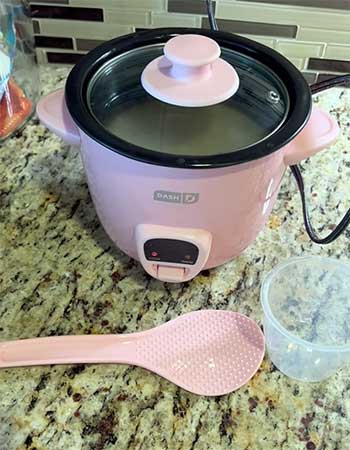
Let me take you back to the day I unboxed this tiny marvel.
I’m your typical busy American—work from home in a cramped apartment in Chicago, juggling Zoom calls and quick meals.
Rice is my go-to side for everything from stir-fries to burrito bowls, but my old method?
A pot on the stove that always left me babysitting it, stirring like a mad scientist to avoid burnt bottoms.
Enter the Dash Mini, shipped in a box smaller than my coffee maker.
I ripped it open, and there it was: sleek white design, about the size of a large mug, with a non-stick pot that gleamed under my kitchen light.
Setup was a breeze—no manuals thicker than a pamphlet, just plug it in, measure a cup of rice (it holds up to two uncooked cups, perfect for one or two people), rinse it under the tap, add water to the marked line, and hit the cook button.
That orange light flicked on, and I walked away to answer emails. Ten minutes later? The switch popped up with a satisfying click, steam wafting out like a tiny victory signal. I fluffed it with the included paddle, and bam—soft, separate grains that didn’t clump like my past disasters.
I’ve used it daily for weeks now. Breakfast congee with oats mixed in? It handled the thicker texture without complaint. Lunchtime jasmine rice for teriyaki chicken? Spot on, with that subtle floral aroma filling my space. Even experimented with quinoa—rinsed, same ratio, and it came out fluffy, not mushy.
Cleanup?
The pot lifts out, wipes clean in seconds, and the exterior stays cool enough I don’t burn my fingers. One afternoon, I overfilled it with broth for risotto-style rice, and while it bubbled a bit, it didn’t overflow or scorch. That’s resilience in a device smaller than my blender.
What surprised me most was how it fits my life. Traveling to my sister’s in New York last weekend, I packed it in my carry-on—no issues at security. At her place, we whipped up coconut rice for a curry night, and everyone raved. It’s not just a gadget; it’s freeing up my counter for that air fryer I finally have room for.
Sure, it’s mini, so if you’re feeding a family of six, look elsewhere. But for me? It’s transformed rushed meals into something reliable and fun. You know that sigh of relief when tech just works? That’s this cooker, every single time.
Also Read: Is Ninja Foodi PossibleCooker Pro Worth It?
The Pros That Make Dash Mini Rice Cooker A Kitchen Staple
- Effortless One-Touch Operation Keeps Things Simple
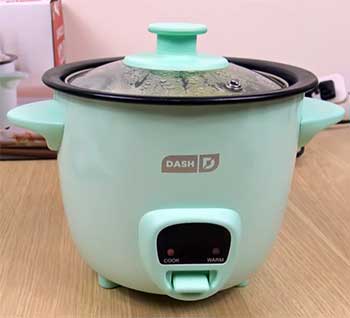
You hit that button, and that’s it—no timers to set, no settings to fiddle with.
I remember my first use, expecting a learning phase, but nope.
It senses when the rice is done and switches to warm mode automatically.
This means you’re not glued to the kitchen, wondering if you’ve overcooked it.
For someone like me who multitasks constantly, this freedom is gold. Imagine prepping veggies while it hums away, and dinner’s ready without a second thought. It’s that reliability that turns cooking from a chore into a background hum.
- Compact Size Fits Anywhere Without the Bulk
At just 8.5 inches tall and wide, this thing tucks into the tiniest corners. My apartment counter is a battlefield of appliances, but the Dash Mini slides next to the toaster like it was made for it. Traveling? It weighs under two pounds, so tossing it in a bag for a road trip to the Smoky Mountains was effortless.
You get full rice-cooking power without sacrificing space—perfect if you’re in a studio or RV. I’ve even kept one at the office for potlucks, and it didn’t hog the break room shelf.
- Affordable Price Without Skimping on Quality
I snagged mine for around 20 bucks, and it feels like stealing. Non-stick coating holds up after dozens of cycles, and the build is sturdy plastic that doesn’t crack under heat. Compared to pricier models, you’re not paying for bells and whistles you won’t use.
It’s the kind of value that makes you smile every time you plug it in, knowing you’ve got pro results on a budget. If you’re starting out or upgrading on the cheap, this delivers without the regret.
- Versatile for More Than Just Rice
Don’t box it in—I’ve steamed veggies right alongside rice by adding a trivet (one came with mine). Quinoa, couscous, even small batches of oatmeal come out perfect. Last week, I did a Mexican rice with tomatoes and spices; the even heat distribution cooked it uniformly, no hot spots.
You can get creative without fear, turning it into your multi-tool for grains. It’s like having a personal chef in miniature form, adapting to whatever whim strikes.
- Energy Efficiency for the Eco-Conscious Cook
This mini beast sips power—less than a toaster oven. In my energy-conscious household (bills add up in the Windy City), it’s a win. No preheating waste, just straight to cooking. Over a month, it barely nudged my usage up, yet it outperforms larger models in speed for small servings.
If you’re watching your carbon footprint or just hate high electric bills, you’ll appreciate how it punches above its weight without the drain.
Also Read: Is PowerXL StirMax Multi-Cooker Worth It?
The Cons You Should Weigh Before Buying Dash Mini Rice Cooker
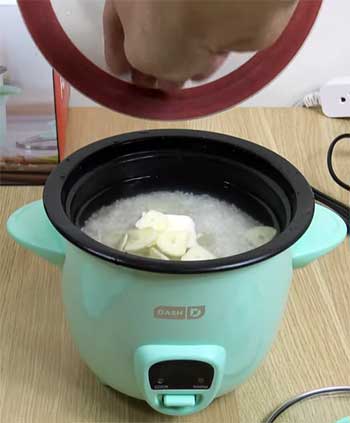
- Limited Capacity for Bigger Meals: Here’s the honest bit: if you’re cooking for four or more, this isn’t your hero. It maxes at two cups uncooked, yielding about four cups cooked—great for solos or couples, but you’ll need multiple batches for crowds. I hosted a game night once and had to run it twice, which felt like a minor hassle. You might pause if family dinners are your norm.
- Basic Features Mean No Frills: Want fuzzy logic or presets for brown rice? Look elsewhere. It’s straightforward cook/warm only, so sticky rices might need tweaks on your end. I adjusted water ratios for basmati, but it took a trial run. If you’re a gadget lover craving apps or delays, this keeps it old-school simple—charming to some, limiting to others.
- Occasional Steaming Issues with Lid: The tempered glass lid is cool for peeking, but it can trap too much steam if not vented right, leading to slightly wetter results on humid days. A quick wipe post-cook fixes it, but it’s a nitpick I’ve noticed in Chicago’s muggy summers. You can manage it, but expect a touch more fluffing.
Maintenance Tips To Keep Dash Mini Rice Cooker Running Like New
- Daily Cleaning Routines That Take Seconds: After each use, unplug it and let it cool for five minutes—you don’t want to warp the pot. Lift out the inner pot, rinse under warm soapy water, and use a soft sponge to avoid scratching the non-stick. I do this while eating, and it’s done before my coffee’s cold. Wipe the heating plate with a damp cloth; no need for harsh cleaners. The paddle and measuring cup? Toss in the dishwasher if you’re lazy like me. Consistency here prevents buildup, keeping your rice tasting fresh every time.
- Deep Cleaning Every Week for Longevity: Once a week, especially if you’re doing flavored rices, give it a vinegar soak. Fill the pot with equal parts water and white vinegar, let it sit for 30 minutes, then run a cycle. This dissolves any mineral deposits from hard water—trust me, in my city tap, it makes a difference. Empty and rinse twice. For the exterior, a microfiber cloth with mild soap keeps fingerprints at bay without streaks. I’ve skipped this a couple times, and odors lingered; now it’s non-negotiable for that like-new performance.
- Storing It Smart to Avoid Wear and Tear: When not in use, air-dry everything completely to dodge mold in humid spots. Wrap the cord loosely around the base—don’t knot it, or you’ll fray the wires over time. Store in a dry cabinet away from direct sun; mine lives on a pull-out shelf for easy grab. If you’re stacking, put a soft mat underneath to cushion impacts. This habit has kept mine pristine after months, ready for spontaneous cooking without dust or dents.
- Troubleshooting Common Hiccups Proactively: If it stops heating evenly, check for rice grains stuck in the base—use a toothpick gently to dislodge. For lid gasket issues, wash it separately; mine softened after a few cycles but plumps back with hot water. Over time, the non-stick might dull, but a light oil rub post-cleaning revives it. Always use the right water ratios to prevent overflow, which can gum up seals. These tweaks have saved me from toss-outs, extending its life way beyond the warranty.
- Seasonal Adjustments for Peak Performance: In winter, when air’s dry, add a splash more water to combat evaporation. Summer humidity? Reduce by a teaspoon to avoid sogginess. I track this in a quick note on my phone, and it fine-tunes results. For hard water areas like mine, a monthly descale with lemon juice keeps minerals from affecting taste. These little adaptations make it feel customized to your home, ensuring it stays your reliable sidekick year-round.
Also Read: Comparison of Tiger And Cuckoo Rice Cookers.
Comparing The Dash Mini To Other Compact Cookers
- Dash Mini Vs. Zojirushi Neuro Fuzzy Rice Cooker
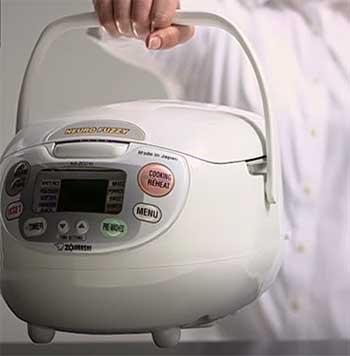
Let’s pit my trusty Dash Mini against the Zojirushi Neuro Fuzzy, that fuzzy logic beast known for its brainy adjustments.
I remember eyeing the Neuro Fuzzy during a kitchen splurge—it’s got this advanced tech that tweaks time and temp based on rice type, promising sushi-grade perfection every batch.
Price-wise, though?
The Dash wins hands down at about 20 bucks versus the Neuro’s 200-plus.
You get what you pay for in precision: the Neuro Fuzzy nails brown rice without babysitting, absorbing moisture just right for that chewy texture I crave in poke bowls. My Dash? It handles white rice flawlessly but needs a water tweak for heartier grains—nothing a quick note on my phone can’t fix.
Size tells another story. The Dash slips into my drawer like a secret agent, while the Neuro Fuzzy hulks at 10 cups capacity, dominating counters like it owns the place. If you’re solo like me, churning out one-cup wonders, the Dash’s mini footprint means no more appliance Tetris.
But for family feasts?
The Neuro’s larger pot shines, cooking enough for leftovers without multiple runs. Energy use? Both sip power, but the Dash edges out for quick zaps—15 minutes flat for jasmine, versus the Neuro’s 45 for the same. I’ve tested both at a friend’s; the Neuro’s steam vent is quieter, less misty mess, but the Dash’s one-touch simplicity had me back to my laptop faster.
You pick: budget-friendly speed or premium polish? For my rushed life, Dash keeps it real without the wallet hit.
- Dash Mini Vs. Zojirushi Micom Rice Cooker

Now, squaring the Dash Mini off with the Zojirushi Micom—another Zojirushi gem with microcomputer smarts for even cooking across varieties. This one’s my daydream upgrade, with settings for GABA rice and porridge that sound fancy.
But let’s talk real talk: the Micom retails around 150, making my Dash feel like the thrift-store steal it is. The Micom’s secret sauce is its retractable cord and keep-warm up to 12 hours without drying—I’ve heard raves from coworkers who swear by it for overnight oats turned rice pudding. My Dash warms for hours too, but it cools quicker if forgotten, which suits my eat-now style fine.
Portability? Dash crushes it. At under two pounds, it’s my travel buddy for weekend getaways, while the Micom’s 5.7-quart bulk stays homebound. I lugged a borrowed Micom to a potluck once—impressive fluffy basmati, no doubt, with that even heat distribution preventing the mushy edges I hate.
Dash matches on small scales, though; its non-stick pot releases grains cleaner, less scraping post-meal. Cleanup’s a tie—both pots pop out easy—but the Micom’s thicker coating resists scratches better over years. Speed? Dash clocks in faster for minis: 20 minutes tops, versus Micom’s 30-50 for precision builds.
If you’re a rice nerd experimenting with textures, Micom’s your lab partner. Me? I love the Dash’s no-brainer vibe—plug, cook, done. It’s the everyday hero over the Micom’s occasional indulgence.
- Dash Mini Vs. Cuckoo Rice Cooker
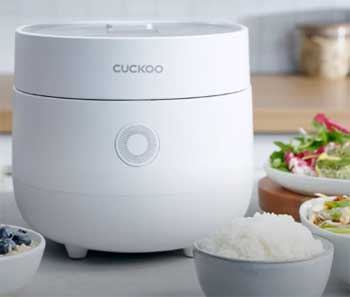
Finally, Dash Mini takes on the Cuckoo Rice Cooker, that Korean powerhouse with pressure-cooking flair for turbo results.
Cuckoo’s CR series, hovering at 100-150 bucks, boasts voice alerts and turbo modes that shave minutes off cooking—perfect for impatient types like you during weeknights.
I tried a friend’s Cuckoo for bibimbap rice; the pressure sealed in flavor, yielding stickier, more aromatic grains than my stovetop ever did.
Dash can’t pressurize, so it steams straightforwardly—great for fluffy separation, but less intense taste infusion. Still, for everyday white rice, Dash’s subtlety wins; no overwhelming steam bursts to fog my tiny kitchen.
Capacity flips the script: Cuckoo’s 6-cup pot feeds crowds effortlessly, ideal if you’re hosting like I do monthly barbecues. My Dash maxes at two cups, so batching is my jam for bigger groups, but it reheats seamlessly without sogginess.
Build quality? Cuckoo’s stainless accents feel premium, holding heat like a champ, while Dash’s plastic is lightweight but prone to fingerprints—easy wipe, though. Versatility edges to Cuckoo with steaming baskets for dumplings mid-rice, expanding to full meals. I’ve steamed broccoli in the Dash with a hacky foil setup, but it’s clunkier.
Power draw? Both efficient, but Cuckoo’s voice chimes add fun feedback—Dash’s click is satisfyingly retro. Bottom line: if speed and multi-tasking rev your engine, Cuckoo’s the thrill ride. For my simple, space-strapped setup, Dash delivers the goods without the extras I skip. You decide—flashy features or fuss-free flow?
Also Read: Comparison of Zojirushi Micom And Neuro Fuzzy Rice Cookers.
Frequently Asked Questions (FAQ)
Absolutely, if you cook small portions—saves space, time, and hassle for daily use.
Up to 2 cups uncooked, yielding about 4-6 cups cooked—ideal for 1-2 people.
Around 15-20 minutes, depending on rice type; it auto-switches to warm.
Rinse rice, add to pot with water (1:1.5 ratio), plug in, press cook—fluff when done.
Wrapping It Up: Make The Dash Mini Your Next Kitchen Move
After months of reliable service, the Dash Mini Rice Cooker isn’t just an appliance—it’s the quiet hero simplifying my meals. From solo suppers to spur-of-the-moment sides, it delivers without drama. If you’re craving effortless, space-saving rice perfection, don’t wait.
Head out and get yours today; your future self will thank you with every fluffy bite. It’s the upgrade that fits your life, big impact in a small package.
